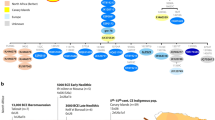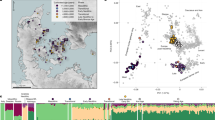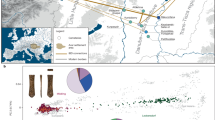Abstract
From the first century AD, Europe has been interested by population movements, commonly known as Barbarian migrations. Among these processes, the one involving the Longobard culture interested a vast region, but its dynamics and demographic impact remains largely unknown. Here we report 87 new complete mitochondrial sequences coming from nine early-medieval cemeteries located along the area interested by the Longobard migration (Czech Republic, Hungary and Italy). From the same areas, we sampled necropoleis characterized by cultural markers associated with the Longobard culture (LC) and coeval burials where no such markers were found, or with a chronology slightly preceding the presumed arrival of the Longobards in that region (NLC). Population genetics analysis and demographic modeling highlighted a similarity between LC individuals, as reflected by the sharing of quite rare haplogroups and by the degree of genetic resemblance between Hungarian and Italian LC necropoleis estimated via a Bayesian approach, ABC. The demographic model receiving the strongest statistical support also postulates a contact between LC and NLC communities, thus indicating a complex dynamics of admixture in medieval Europe.
Similar content being viewed by others
Log in or create a free account to read this content
Gain free access to this article, as well as selected content from this journal and more on nature.com
or
Data and software availability
All newly generated data have been deposited in GenBank: MG182446–MG182470 and MG182472–MG182533.
References
Bemmann J, Schmauder M, editors. Die Langobarden in den Schriftquellen bis zu den Markomannenkriegen. Proceedings of the Mitteleuropa Langobarden – Awaren – Slawen. p. 43–50; Frankfurt a.M., Bonn: Habelt, 2008.
Geary P. The myth of nations. The medieval origins of Europe. Princeton: Princeton University Press; 2002.
Koncz I. A historical date and its archaeological consequences. Acta Archaeol Acad Sci Hung 2015;66:315–40.
Giostra C. Goths and Lombards in Italy: the potential of archaeology with respect to ethnocultural identification. Eur J Post-Class Archaeol. 2011;1:7–36.
Vai S, Ghirotto S, Pilli E, Tassi F, Lari M, Rizzi E, et al. Genealogical relationships between early medieval and modern inhabitants of Piedmont. PLoS ONE. 2015;10:e0116801.
Vai S, Lari M, Ghirotto S, Rizzi E, Achilli A, Olivieri A, et al. Diachronic and synchronic genetic analysis of ancient Piedmont population. J Biol Res. 2012;1:LXXXV.
Alt KW, Knipper C, Peters D, Müller W, Maurer AF, Kolliget I, al. Lombards on the move-an integrative study of the migration period cemetery at Szolad, Hungary. PLoS ONE. 2014;9:e110793.
Pinhasi R, Fernandes D, Sirak K, Novak M, Connell S, Alpaslan-Roodenberget S, al. Optimal ancient DNA yields from the inner ear part of the human petrous bone. PLoS ONE. 2015;10:e0129102.
Dabney J, Knapp M, Glocke I, Gansauge MT, Weihmann A, Nickel B, et al. Complete mitochondrial genome sequence of a Middle Pleistocene cave bear reconstructed from ultrashort DNA fragments. Proc Natl Acad Sci USA. 2013;110:15758–63.
Meyer M, Kircher M. Illumina sequencing library preparation for highly multiplexed target capture and sequencing. Cold Spring Harb Protoc. 2010;2010:pdb.prot5448.
Maricic T, Whitten M, Pääbo S. Multiplexed DNA sequence capture of mitochondrial genomes using PCR products. PLoS ONE. 2010;5:e14004.
Modi A, Tassi F, Susca RR, Vai S, Rizzi E, De Bellis G, et al. Complete mitochondrial sequences from Mesolithic Sardinia. Sci Rep. 2017;7:42869.
Jónsson H, Ginolhac A, Schubert M, Johnson PLF, Orlando L. mapDamage2.0: fast approximate Bayesian estimates of ancient DNA damage parameters. Bioinformatics. 2013;29:1682–4.
Fu Q, Mittnik A, Johnson Philip LF, Bos K, Lari M, Bollongino R, et al. A revised timescale for human evolution based on ancient mitochondrial genomes. Curr Biol. 2013;23:553–9.
Kloss-Brandstatter A, Pacher D, Schonherr S, Weissensteiner H, Binna R, Specht G, et al. HaploGrep: a fast and reliable algorithm for automatic classification of mitochondrial DNA haplogroups. Hum Mutat. 2011;32:25–32.
van Oven M. PhyloTree Build 17: Growing the human mitochondrial DNA tree. Forensic Sci Int. 2015;5:e392–e394.
Bandelt HJ, Forster P, Sykes BC, Richards MB. Mitochondrial portraits of human populations using median networks. Genetics. 1995;141:743–53.
Csakyova V, Szecsenyi-Nagy A, Csosz A, Nagy M, Fusek G, Langó P, et al. Maternal genetic composition of a medieval population from a Hungarian-Slavic contact zone in Central Europe. PLoS ONE. 2016;11:e0151206.
Kassambara A, Mundt F. Factoextra: extract and visualize the results of multivariate data analyses. R package version. J Stat Softw. 2016;25:1–18.
R Develompment Core Team. R: a language and environment for statistical computing. Vienna, Austria: the R Foundation for Statistical Computing. http://www.R-project.org/; 2011.
Tassi F, Vai S, Ghirotto S, Lari M, Modi A, Pilli E, et al. Genome diversity in the Neolithic Globular Amphorae culture and the spread of Indo-European languages. Proc Biol Sci. 2017;284:20171540.
Schiffels S, Haak W, Paajanen P, Llamas B, Popescu E, Loe L, et al. Iron Age and Anglo-Saxon genomes from East England reveal British migration history. Nat Commun. 2016;7:10408.
Allentoft ME, Sikora M, Sjogren KG, Rasmussen S, Rasmussen M, Stenderup J, et al. Population genomics of Bronze Age Eurasia. Nature. 2015;522:167–72.
Gunther T, Valdiosera C, Malmstrom H, Ureña I, Rodriguez-Varela R, Sverrisdóttir ÓO, et al. Ancient genomes link early farmers from Atapuerca in Spain to modern-day Basques. Proc Natl Acad Sci USA. 2015;112:11917–22.
Haak W, Lazaridis I, Patterson N, Rohland N, Mallick S, Llamas B, et al. Massive migration from the steppe was a source for Indo-European languages in Europe. Nature. 2015;522:207–11.
Lipson M, Szecsenyi-Nagy A, Mallick S, Pósa A, Stégmár B, Keerl V, et al. Parallel palaeogenomic transects reveal complex genetic history of early European farmers. Nature. 2017;551:368–72.
Martiniano R, Caffell A, Holst M, Hunter-Mann K, Montgomery J, Müldner G, et al. Genomic signals of migration and continuity in Britain before the Anglo-Saxons. Nat Commun. 2016;7:10326.
Mathieson I, Lazaridis I, Rohland N, Mallick S, Patterson N, Roodenberg SA, et al. Genome-wide patterns of selection in 230 ancient Eurasians. Nature. 2015;528:499–503.
Mittnik A, Wang CC, Pfrengle S, Daubaras M, Zariņa G, Hallgren F, et al. The genetic prehistory of the Baltic Sea region. Nat Commun. 2018;9:442.
Neparaczki E, Kocsy K, Toth GE, Maróti Z, Kalmár T, Bihari P, et al. Revising mtDNA haplotypes of the ancient Hungarian conquerors with next generation sequencing. PLoS ONE. 2017;12:e0174886.
Olalde I, Brace S, Allentoft ME, Armit I, Kristiansen K, Booth T, et al. The Beaker phenomenon and the genomic transformation of northwest Europe. Nature. 2018;555:190–6.
Rusu I, Modi A, Vai S, Pilli E, Mircea C, Radu C, et al. Maternal DNA lineages at the gate of Europe in the 10th century AD. PLoS ONE. 2018;13:e0193578.
Batini C, Hallast P, Vagene AJ, Zadik D, Eriksen HA, Pamjav H, et al. Population resequencing of European mitochondrial genomes highlights sex-bias in Bronze Age demographic expansions. Sci Rep. 2017;7:12086.
Excoffier L, Lischer HE. Arlequin suite ver 3.5: a new series of programs to perform population genetics analyses under Linux and Windows. Mol Ecol Resour. 2010;10:564–7.
Jombart T. adegenet: a R package for the multivariate analysis of genetic markers. Bioinformatics. 2008;24:1403–5.
Jombart T, Ahmed I. adegenet 1.3-1: new tools for the analysis of genome-wide SNP data. Bioinformatics. 2011;27:3070–1.
Jombart T, Devillard S, Balloux F. Discriminant analysis of principal components: a new method for the analysis of genetically structured populations. BMC Genet. 2010;11:94.
Amorim CEG, Vai S, Posth C, Modi A, Koncz I, Hakenbeck S, et al. Understanding 6th-century barbarian social organization and migration through paleogenomics. Nat Commun. 2018;9:3547.
Wegmann D, Leuenberger C, Neuenschwander S, Excoffier L. ABCtoolbox: a versatile toolkit for approximate Bayesian computations. BMC Bioinformatics. 2010;11:116.
Pudlo P, Marin JM, Estoup A, Cornuet JM, Gautier M, Robert CP. Reliable ABC model choice via random forests. Bioinformatics. 2016;32:859–66.
Breiman L. Random forests. Mach Learn. 2001;45:5–32.
Beaumont MA, Zhang W, Balding DJ. Approximate Bayesian computation in population genetics. Genetics. 2002;162:2025–35.
Hamilton G, Stoneking M, Excoffier L. Molecular analysis reveals tighter social regulation of immigration in patrilocal populations than in matrilocal populations. Proc Natl Acad Sci USA. 2005;102:7476–80.
Kivisild T. Maternal ancestry and population history from whole mitochondrial genomes. Investig Genet. 2015;6:3.
Hedman M, Brandstatter A, Pimenoff V, Sistonen P, Palo JU, Parson W, et al. Finnish mitochondrial DNA HVS-I and HVS-II population data. Forensic Sci Int. 2007;172:171–8.
Acknowledgements
We would like to thank Angela Livia Casadei for her help in the analysis of genetic data. This study has been supported by the following institutions and foundations: Riksbankens Jubileumsfond, Alexander von Humboldt Stiftung, Bundesministerium für Bildung und Forschung, Gerard B. Lambert Foundation, Università degli Studi di Padova, Institute for Advanced Study. KV and PG were supported by NSF #1450606. GB, AB and FT were supported by the ERC Advanced Grant Agreement No. 295733, ‘LanGeLin’ project.
Author information
Authors and Affiliations
Corresponding authors
Ethics declarations
Conflict of interest
The authors declare that they have no conflict of interest.
Additional information
Publisher’s note: Springer Nature remains neutral with regard to jurisdictional claims in published maps and institutional affiliations.
Supplementary information
Rights and permissions
About this article
Cite this article
Vai, S., Brunelli, A., Modi, A. et al. A genetic perspective on Longobard-Era migrations. Eur J Hum Genet 27, 647–656 (2019). https://doi.org/10.1038/s41431-018-0319-8
Received:
Revised:
Accepted:
Published:
Issue date:
DOI: https://doi.org/10.1038/s41431-018-0319-8
This article is cited by
-
Mitogenomic diversity and stable isotopes provide insights into the maternal genetic history, mobility patterns, and diet of early medieval individuals from the Eastern Italian Alps
Archaeological and Anthropological Sciences (2022)
-
Integrated petrographic and geochemical analysis of the Langobard age pottery of Szólád, Western Hungary
Archaeological and Anthropological Sciences (2022)
-
Genetic evidence suggests a sense of family, parity and conquest in the Xiongnu Iron Age nomads of Mongolia
Human Genetics (2021)
-
The mitogenome portrait of Umbria in Central Italy as depicted by contemporary inhabitants and pre-Roman remains
Scientific Reports (2020)
-
Genetic kinship and admixture in Iron Age Scytho-Siberians
Human Genetics (2019)



